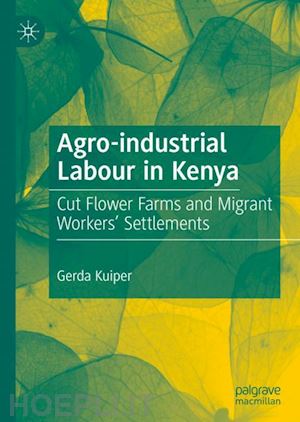
Questo prodotto usufruisce delle SPEDIZIONI GRATIS
selezionando l'opzione Corriere Veloce in fase di ordine.
Pagabile anche con Carta della cultura giovani e del merito, 18App Bonus Cultura e Carta del Docente
This ethnography analyses labour relations within the export-oriented cut flower industry at Lake Naivasha in Kenya. Though this agro-industry has attracted critical attention from journalists and non-governmental organizations, this book is the first comprehensive, social scientific analysis of the industry’s labour arrangements and production processes. Gerda Kuiper here interprets the work on the farms as ‘agro-industrial labour’: a labour system characterized by high levels of discipline and a strict rhythm of work, due to the demands posed by a highly perishable agricultural product. This framework enables the author to draw on insights from a wide range of anthropological and sociological studies on (agro-)industrial wage labour around the globe. This mixed-methods approach, deployed alongside rich ethnographic detail, allows the author to center the flower farm workers in her analysis.
2.1 Colonial Period: Settlers and Squatters
2.2 After Independence: “A Farming Town with Steady Growth”
2.3 Blooming Business: The Establishment of the Cut Flower Industry
2.4 Naivasha in the Twenty-First Century: Paradise Lost?2.5 Conclusion: Naivasha’s Past and Present
Bibliography
3.1 Three Workers
3.1.1 Flora
3.1.2 Lucy
3.1.3 Glory
3.2 The Decision to Move
3.3 Finding a Place to Stay
3.4 Finding a Job: The Naivasha Labour Market
3.5 Finding a Job: Farm’s Recruitment Processes
3.6 Finding a Job: Migrant Workers’ Preferences
3.7 Conclusion: The Use of Networks
Bibliography4.1 The Lay-out of the Farms
4.2 Daily Routines: Accountability and “Responsibilisation”
4.3 Rhythms of Labour: Yielding to the Flowers and the Markets
4.4 Farm Hierarchies: Discipline and Social Distance
4.5 Unskilled Labour? The Need for Stability and Experience
4.6 Changing Labour Conditions: Standardization and Unionization
4.7 Gender on the Farms: Divisions of Labour, Sexual Harassment, and Gender Committees
4.8 Ethnicity on the Work Floor: Which Language to Speak?
4.9 Conclusion: Disciplined Labour
Bibliography
5.1 The Establishment of Settlements in Kenya
5.2 The Eight Naivasha Workers’ Settlements
5.2.1 Karagita
5.2.2 Trading centres DCK/Sulmac and Kongoni
5.2.3 Kihoto
5.2.4 Kamere and Kwa Muhia
5.2.5 Kasarani
5.2.6 KCC
5.3 The Economic Position of Settlements’ Residents: “Hustling” and “Struggling”
5.4 The Settlements’ Illicit Economies: Fish Poaching, Chang’aa, and Sex Work
5.5 Ethnicity in the Settlements: Mixed Marriages and Mutual Mistrust
5.6 Community Relations: Churches, “Self-help Groups”, Colleagues, and Neighbours5.7 Governing the Settlements: Creating Order and Allowing for Disorder
5.8 Conclusion: “Spontaneous” Settlements?
Bibliography
6.1 The Meaning(s) of Home
6.2 Strategies for the Future: Constructing a “Home”
6.2.1 Investing in Networks: Visits and Remittances
6.2.2 Investing in Assets: Plots and Livestock
6.2.3 Investing in Groups: Participation in Organizations
6.2.4 Postponing the Future: Flora and James
6.2.5 A Woman’s Future: Helen
6.2.6 A Future in Naivasha: Moses
6.3 Leaving Naivasha: Wage Labour Pasts?6.4 Conclusion: Securing the Future
Bibliography
Gerda Kuiper, Ph.D., is a cultural anthropologist with a regional focus on Eastern Africa, a thematic focus on economic anthropology and globalization, and a strong interdisciplinary commitment.











Il sito utilizza cookie ed altri strumenti di tracciamento che raccolgono informazioni dal dispositivo dell’utente. Oltre ai cookie tecnici ed analitici aggregati, strettamente necessari per il funzionamento di questo sito web, previo consenso dell’utente possono essere installati cookie di profilazione e marketing e cookie dei social media. Cliccando su “Accetto tutti i cookie” saranno attivate tutte le categorie di cookie. Per accettare solo deterninate categorie di cookie, cliccare invece su “Impostazioni cookie”. Chiudendo il banner o continuando a navigare saranno installati solo cookie tecnici. Per maggiori dettagli, consultare la Cookie Policy.